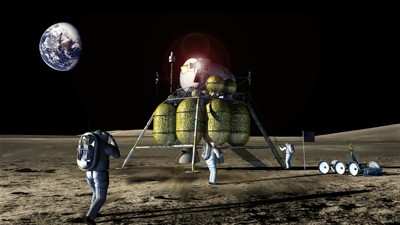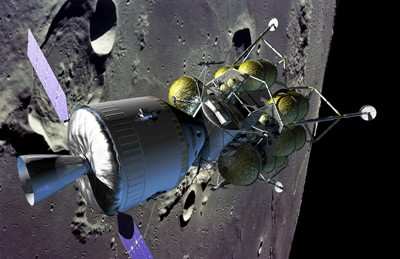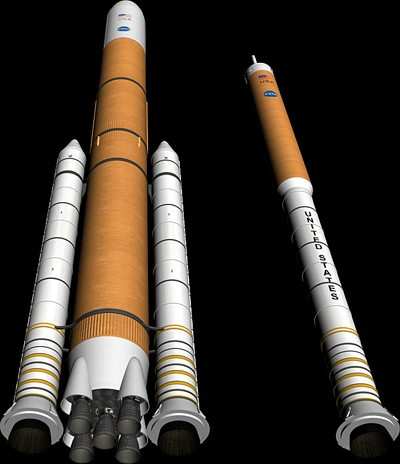Let's Roll Back 30 Years And Build On Apollo
by Aero-News Senior Correspondent Kevin R.C. "Hognose"
O'Brien
 In a Page 1A Story in USA Today NASA
Administrator Michael Griffin told us what he thinks of the Space
Shuttle and International Space Station projects: they were
mistakes.
In a Page 1A Story in USA Today NASA
Administrator Michael Griffin told us what he thinks of the Space
Shuttle and International Space Station projects: they were
mistakes.
"It is now commonly accepted," Griffin told the newspaper's
Editorial Board, that developing the Space Shuttle and discarding
the progress of the space program to that date, including the
moon-landing Apollo Project, "was not the right path."
Now he tells us.
But Griffin is only saying what a growing chorus of critics have
said: the Shuttle never fulfilled its promise of cheap, fast,
rapid-turn-around flight to orbit, and it never aimed higher than
orbit.
Griffin sounded equally sour on the ISS, although he did not go
so far as to say that a space station in general was a bad idea.
"Had the decision been mine, we would not have built the space
station we're building in the orbit we're building it in," is what
he told the editors.
He faulted the Shuttle for being an "extremely aggressive
[design] and just barely possible."
"We are now trying to change the path while doing as little
damage as we can," Griffin said. The new NASA vision heads on, to
the moon, to the planets. The trick is doing that while retaining
NASA's massive investment in hardware -- and in people.

President Bush's vision for NASA sees a Space Shuttle retirement
by 2010 and a return to manned interplanetary exploration.
The ISS as it's been understood up to now is probably doomed;
without scores of additional shuttle flights it can't be finished,
and a look at the sort of science it produces so far, as given in
the expedition reports and schedules of the ISS crews, is
disappointing -- there are a lot of experiments devised by
somebody's middle-school science class in there.
In order to maintain the ISS schedule, NASA committed to
abandonment of the Hubble Space Telescope, which has produced
paradigm-shifting science.

USA Today consulted an expert who estimated the cost of the
Shuttle at $150 billion from 1971 to date, and the ISS at
$100 million so far (although some of the latter cost has been born
by such partners as Russia, Japan and Canada). To put that in
perspective, it's about what the Louisiana congressional delegation
has demanded for Katrina relief, and rather more than the cost of
the Iraq and Afghanistan wars combined.
The problem with money for NASA, especially for a NASA with an
interplanetary focus, is that the moon and the planets are not in
any Congressman's district. The recent highway bill with it's 6,300
earmarked projects, like the famous Don Young Bridge to Nowhere in
Alaska, illustrates where their priorities are.

So the Shuttle takes its place as one of the bad ideas of the
1970s, along with WIN buttons, tie-dyed bell bottoms, the Pinto,
Vega and Gremlin, seatbelt-ignition interlocks, the Continental
Tiara engine, and KC and the Sunshine Band.
That is unlikely to be accepted by any of the thousands of
people who worked in the program during these last thirty years.
Joe Rothenburg, head of manned programs during the second Clinton
administration, defended the programs to USA Today, while admitting
that there could have been other ways of doing things.
Changing an organization's direction is very hard -- it's
especially hard to do without damaging employee morale, and the
prouder the organization, the harder it gets. Mike Griffin has a
leadership challenge on his hands. Can you imagine how it feels to
be a shuttle astronaut, up in the air about whether you will ever
fly, and now hearing that your organization is about to deep-six
the system you have spent six years, or ten, or a career on?
Imagine how the engineers feel, the ones who created this textbook
example of extreme engineering and set it to fly in the most
hostile conditions man has every traveled through.

What has Mike got to offer these people, in place of the dreams
they had?
Well, there is the moon....
 Unfortunate... ANN/SportPlane Resource Guide Adds To Cautionary Advisories
Unfortunate... ANN/SportPlane Resource Guide Adds To Cautionary Advisories ANN FAQ: Turn On Post Notifications
ANN FAQ: Turn On Post Notifications ANN's Daily Aero-Term (04.29.24): Visual Approach Slope Indicator (VASI)
ANN's Daily Aero-Term (04.29.24): Visual Approach Slope Indicator (VASI) ANN's Daily Aero-Term (04.28.24): Airport Marking Aids
ANN's Daily Aero-Term (04.28.24): Airport Marking Aids ANN's Daily Aero-Linx (04.28.24)
ANN's Daily Aero-Linx (04.28.24)







